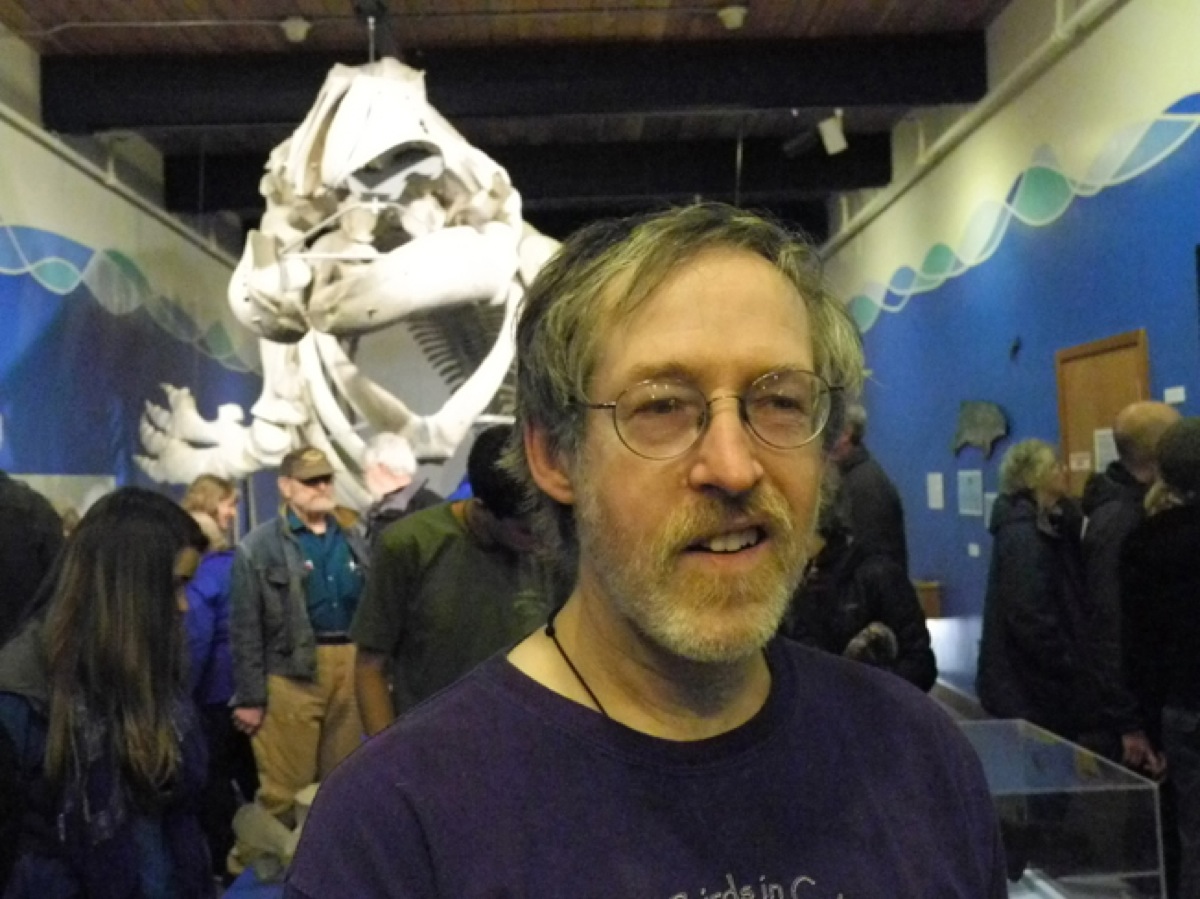The title of the Pratt Museum’s new exhibit tells it all: “Encounters: Whales in Our Waters.”
And by “encounter,” does the museum ever mean encounter.
Not only does the exhibit include stories, trip logs and photographs of people’s interactions with whales, it includes a 38-foot, fully articulated gray whale skeleton hanging at eye level.
“It’s in your face and front and center and up front and personal,” said Lee Post, the bone expert who organized articulating the skeleton last summer.
Displayed at the back of the long and narrow gallery, the whale’s tail curves down the stairway and mezzanine. Curator of collections Scott Bartlett designed a paint scheme of sea-blue on the walls that looks like the whale is swimming underwater.
Also included in the exhibit is the first big skeleton Post helped articulate in 1979 — and the one that got him into the business of putting bones together — a Stejneger’s beaked whale. There also is a harbor porpoise skeleton in pieces and several skulls.
The idea for the exhibit came out of discussions museum staff had about what should be included in the master exhibit of the new museum building. The idea of including whales was mentioned. A temporary exhibit was suggested as a way to explore how whales could be in the master plan. Former curator of collections Holly Cusack-McVeigh had the idea of finally putting together the gray whale skeleton that had laid around in pieces since 2001.
Bartlett got slammed with the ultimate job interview question when he visited the Pratt last summer. Post and his team of more than 100 volunteers were finishing up the skeleton. If Bartlett took the job, his first big project would be “Encounters,” he was told.
“They were pretty up front about it,” Bartlett said.
After starting his new job last September, he jumped into the exhibit flukes first. Meeting with a team of scientists and writers, Bartlett and the group came up with the exhibit’s basic plan.
“What do people want to know?” he said. “What are the questions people have? How can we make this a personal exhibit so people can connect?”
The exhibit includes the main whale species that visit or live in Kachemak Bay and lower Cook Inlet. To be precise, “whales” isn’t the right term, but “cetacea,” the Latin name for the order that includes baleen whales like the gray whale and toothed whales like the killer whale and harbor porpoises.
“It’s like if you were out on a boat in Kachemak Bay and lower Cook Inlet and you could see everything, you might see these guys,” Bartlett said.
Halibut Cove artist Janet Carroll painted outlines of the whales and porpoises to scale, with a human scuba diver as well. The whales “swim” against that blue background. Bartlett sketched out the wave design with artist Kathy Smith and other volunteers doing the painting. That blue makes the pale-gray bones stand out more, Bartlett said. Hands on exhibits include pieces of baleen from the whales. Recordings of whale songs also play at the exhibit.
A minke whale skull has plates of baleen to show how such whales filter plankton to feed. A mouthful of humpback whale baleen is being prepared to show how the process works.
“Baleen is one of those things hard to wrap your head around,” Bartlett said. “When you look at this big thing, that’s how it works.”
For visiting school groups, Bartlett has a special treat: a simulated bag of blubber to show how warm blooded marine mammals stay warm in Alaska oceans. Students can slip their hands into a plastic bag lined with sealed bags of Crisco and then into icy water to see how fat insulates against cold.
Bartlett also is setting up an online blog through the Pratt website for people to share their stories of encounters with whales. Stories he’s already collected from old timers, scientists and writers are in the exhibit.
There’s another story the exhibit tells.
“The gray whale of course is really the community story,” Bartlett said. “So many people have encountered this whale over the project, over the last 13 years.”
In 1999, after water taxi operator Glen Caldwell found a gray whale carcass floating in Halibut Cove Lagoon, volunteers had the stinky job of cutting up the whale. The bones were lowered to the ocean bottom in crab pots for sea critters to eat away the flesh. Post buried the flippers in a raised bed of horse manure at the Pratt. After pulling up the pots with the bones and digging up the flippers, the bones were cleaned. The skull was hung from a roofed porch at the museum and the rest of the bones left in the museum’s crawlspace.
Cleaning, repairing, painting and articulating the gray whale skeleton would be a huge task, Post figured. After a “Meet Your Whale” meeting, only 10 people signed up for specific days and tasks. Post didn’t think he’d get enough volunteers. On the first day, 21 showed up. The next day, 14 people came. It went on like that all summer.
The late Gaye Wolfe, who died several months after the skeleton was done, used her artistic touch to paint the bones a uniform color. Post said he thought Wolfe would just show up and show people what to do.
“She just kept coming back and coming back,” Post said “She was the one who had the touch.”
“Encounters” will be up through July 31. The gray whale skeleton will find a permanent home in the new museum. Until then, it’s designed to break up into sections.
“It’s an amazingly and impressive exhibit for a temporary exhibit for a small town,” Post said. “There are very few places you can get that close to a whale skeleton in a museum setting.”
Michael Armstrong can be reached at michael.armstrong@homernews.com.


